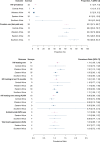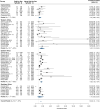Population sizes, HIV prevalence, and HIV prevention among men who paid for sex in sub-Saharan Africa (2000-2020): A meta-analysis of 87 population-based surveys
- PMID: 35077459
- PMCID: PMC8789156
- DOI: 10.1371/journal.pmed.1003861
Population sizes, HIV prevalence, and HIV prevention among men who paid for sex in sub-Saharan Africa (2000-2020): A meta-analysis of 87 population-based surveys
Abstract
Background: Key populations, including sex workers, are at high risk of HIV acquisition and transmission. Men who pay for sex can contribute to HIV transmission through sexual relationships with both sex workers and their other partners. To characterize the population of men who pay for sex in sub-Saharan Africa (SSA), we analyzed population size, HIV prevalence, and use of HIV prevention and treatment.
Methods and findings: We performed random-effects meta-analyses of population-based surveys conducted in SSA from 2000 to 2020 with information on paid sex by men. We extracted population size, lifetime number of sexual partners, condom use, HIV prevalence, HIV testing, antiretroviral (ARV) use, and viral load suppression (VLS) among sexually active men. We pooled by regions and time periods, and assessed time trends using meta-regressions. We included 87 surveys, totaling over 368,000 male respondents (15-54 years old), from 35 countries representing 95% of men in SSA. Eight percent (95% CI 6%-10%; number of surveys [Ns] = 87) of sexually active men reported ever paying for sex. Condom use at last paid sex increased over time and was 68% (95% CI 64%-71%; Ns = 61) in surveys conducted from 2010 onwards. Men who paid for sex had higher HIV prevalence (prevalence ratio [PR] = 1.50; 95% CI 1.31-1.72; Ns = 52) and were more likely to have ever tested for HIV (PR = 1.14; 95% CI 1.06-1.24; Ns = 81) than men who had not paid for sex. Men living with HIV who paid for sex had similar levels of lifetime HIV testing (PR = 0.96; 95% CI 0.88-1.05; Ns = 18), ARV use (PR = 1.01; 95% CI 0.86-1.18; Ns = 8), and VLS (PR = 1.00; 95% CI 0.86-1.17; Ns = 9) as those living with HIV who did not pay for sex. Study limitations include a reliance on self-report of sensitive behaviors and the small number of surveys with information on ARV use and VLS.
Conclusions: Paying for sex is prevalent, and men who ever paid for sex were 50% more likely to be living with HIV compared to other men in these 35 countries. Further prevention efforts are needed for this vulnerable population, including improved access to HIV testing and condom use initiatives. Men who pay for sex should be recognized as a priority population for HIV prevention.
Conflict of interest statement
I have read the journal’s policy and the authors of this manuscript have the following competing interests: MM-G reports funding from UNAIDS, the World Health Organization, the Institut national d’excellence en santé et services sociaux, the Institut national de santé publique du Québec, and an investigator-initiated grant from Gilead Sciences Inc., outside the submitted work. JS is supported by a doctoral award from the Fonds de recherche du Quebec-Sante (FRQS). JWE reports grants from UNAIDS, the Bill & Melinda Gates Foundation, US National Institutes of Health, and the World Health Organization and personal fees from the World Health Organization, all outside of the submitted work. All other authors declare no competing interests.
Figures





References
-
- Joint United Nations Programme on HIV/AIDS. UNAIDS data 2020. Geneva: Joint United Nations Programme on HIV/AIDS; 2020. [cited 2021 May 17]. Available from: https://www.unaids.org/sites/default/files/media_asset/2020_aids-data-bo....
-
- Joint United Nations Programme on HIV/AIDS. Fast track: ending the AIDS epidemic by 2030. Geneva: Joint United Nations Programme on HIV/AIDS; 2014. [cited 2021 May 17]. Available from: https://www.unaids.org/sites/default/files/media_asset/JC2686_WAD2014rep....
-
- World Health Organization. Consolidated guidelines on HIV prevention, diagnosis, treatment, and care for key populations. Geneva: World Health Organization; 2016. [cited 2021 May 17]. Available from: http://apps.who.int/iris/bitstream/handle/10665/246200/9789241511124-eng.... - PubMed
Publication types
MeSH terms
Grants and funding
LinkOut - more resources
Full Text Sources
Medical
Research Materials
Miscellaneous

